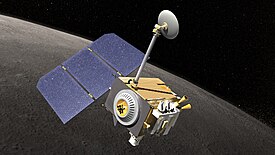
Back مستكشف القمر المداري Arabic Лунар Риконъсънс Орбитър Bulgarian Lunar Reconnaissance Orbiter BS Lunar Reconnaissance Orbiter Catalan Lunar Reconnaissance Orbiter Czech Lunar Reconnaissance Orbiter Danish Lunar Reconnaissance Orbiter German Lunar Reconnaissance Orbiter Esperanto Lunar Reconnaissance Orbiter Spanish Lunar Reconnaissance Orbiter Estonian
 Illustration of LRO | |||||||||||||||||
| Mission type | Lunar orbiter | ||||||||||||||||
|---|---|---|---|---|---|---|---|---|---|---|---|---|---|---|---|---|---|
| Operator | NASA | ||||||||||||||||
| COSPAR ID | 2009-031A | ||||||||||||||||
| SATCAT no. | 35315 | ||||||||||||||||
| Website | lunar | ||||||||||||||||
| Mission duration | |||||||||||||||||
| Spacecraft properties | |||||||||||||||||
| Manufacturer | NASA / GSFC | ||||||||||||||||
| Launch mass | 1,916 kg (4,224 lb)[3] | ||||||||||||||||
| Dry mass | 1,018 kg (2,244 lb)[3] | ||||||||||||||||
| Payload mass | 92.6 kg (204 lb)[3] | ||||||||||||||||
| Dimensions | Launch: 390 × 270 × 260 cm (152 × 108 × 103 in)[3] | ||||||||||||||||
| Power | 1850 W[4] | ||||||||||||||||
| Start of mission | |||||||||||||||||
| Launch date | June 18, 2009, 21:32:00 UTC | ||||||||||||||||
| Rocket | Atlas V 401 | ||||||||||||||||
| Launch site | Cape Canaveral SLC-41 | ||||||||||||||||
| Contractor | United Launch Alliance | ||||||||||||||||
| Entered service | September 15, 2009 | ||||||||||||||||
| Orbital parameters | |||||||||||||||||
| Reference system | Selenocentric | ||||||||||||||||
| Semi-major axis | 1,825 km (1,134 mi) | ||||||||||||||||
| Periselene altitude | 20 km (12 mi) | ||||||||||||||||
| Aposelene altitude | 165 km (103 mi) | ||||||||||||||||
| Epoch | May 4, 2015[5] | ||||||||||||||||
| Moon orbiter | |||||||||||||||||
| Orbital insertion | June 23, 2009 | ||||||||||||||||
| |||||||||||||||||

| |||||||||||||||||
The Lunar Reconnaissance Orbiter (LRO) is a NASA robotic spacecraft currently orbiting the Moon in an eccentric polar mapping orbit.[6][7] Data collected by LRO have been described as essential for planning NASA's future human and robotic missions to the Moon.[8] Its detailed mapping program is identifying safe landing sites, locating potential resources on the Moon, characterizing the radiation environment, and demonstrating new technologies.[9][10]
Launched on June 18, 2009,[11] in conjunction with the Lunar Crater Observation and Sensing Satellite (LCROSS), as the vanguard of NASA's Lunar Precursor Robotic Program,[12] LRO was the first United States mission to the Moon in over ten years.[13] LRO and LCROSS were launched as part of the United States's Vision for Space Exploration program.
The probe has made a 3-D map of the Moon's surface at 100-meter resolution and 98.2% coverage (excluding polar areas in deep shadow),[14] including 0.5-meter resolution images of Apollo landing sites.[15][16] The first images from LRO were published on July 2, 2009, showing a region in the lunar highlands south of Mare Nubium (Sea of Clouds).[17]
The total cost of the mission is reported as US$583 million, of which $504 million pertains to the main LRO probe and $79 million to the LCROSS satellite.[18] LRO has enough fuel to continue operations until at least 2026.[19]
- ^ a b c "LRO Mission Description". PDS Geosciences Node. Washington University in St. Louis. September 24, 2012 [2007]. Retrieved October 9, 2015.
- ^ Hand, Eric (September 3, 2014). "NASA extends seven planetary missions". Science. Retrieved October 9, 2015.
- ^ a b c d "Lunar Reconnaissance Orbiter (LRO): Leading NASA's Way Back to the Moon" (PDF). NASA. June 2009. NP-2009-05-98-MSFC. Archived from the original (PDF) on October 27, 2009. Retrieved October 9, 2015.
- ^ "LRO Spacecraft Description". PDS Geosciences Node. Washington University in St. Louis. April 11, 2007. Retrieved October 9, 2015.
- ^ Neal-Jones, Nancy (May 5, 2015). "NASA's LRO Moves Closer to the Lunar Surface". NASA. Retrieved October 9, 2015.
- ^ Petro, N. E.; Keller, J. W. (2014). Five Years at the Moon With the Lunar Reconnaissance Orbiter (LRO): New Views of the Lunar Surface and Environment (PDF). Annual Meeting of the Lunar Exploration Analysis Group. October 22–24, 2014. Laurel, Maryland. Lunar and Planetary Institute.
- ^ "The Current Location of the Lunar Reconnaissance Orbiter". Arizona State University. Retrieved September 24, 2014.
- ^ Steigerwald, Bill (April 16, 2009). "LRO to Help Astronauts Survive in Infinity". NASA. Archived from the original on August 1, 2016. Retrieved July 13, 2016.
- ^ "LRO Mission Overview". NASA. Retrieved October 3, 2009.
- ^ Houghton, Martin B.; Tooley, Craig R.; Saylor, Richard S. (2006). Mission design and operation considerations for NASA's Lunar Reconnaissance Orbiter (PDF). 57th International Astronautical Congress. October 2–6, 2006. Valencia, Spain. IAC-07-C1.7.06.
- ^ "Lunar Reconnaissance Orbiter: Launch". Goddard Space Flight Center. Archived from the original on February 14, 2013. Retrieved March 22, 2008.
- ^ Mitchell, Brian. "Lunar Precursor Robotic Program: Overview & History". NASA. Archived from the original on July 30, 2009. Retrieved August 5, 2009.
- ^ Dunn, Marcia (June 18, 2009). "NASA launches unmanned Moon shot, first in decade". ABC News. Associated Press. Archived from the original on August 20, 2009. Retrieved August 5, 2009.
- ^ "NASA Probe Beams Home Best Moon Map Ever". Space.com. November 18, 2011. Retrieved September 3, 2016.
- ^ Phillips, Tony; Barry, Patrick L. (July 11, 2005). "Abandoned Spaceships". NASA. Archived from the original on August 8, 2009. Retrieved August 5, 2009.
- ^ "LRO Sees Apollo Landing Sites". LROC. NASA. July 17, 2009.
- ^ Garner, Robert, ed. (July 2, 2009). "LRO's First Moon Images". NASA. Archived from the original on August 8, 2009. Retrieved August 5, 2009.
- ^ Harwood, William (June 18, 2009). "Atlas 5 rocket launches NASA Moon mission". CNet.com. Archived from the original on November 3, 2013. Retrieved June 18, 2009.
- ^ Clark, Stephen (June 18, 2019). "10 years since its launch, NASA lunar orbiter remains crucial for moon landings". Spaceflight Now. Retrieved June 20, 2019.